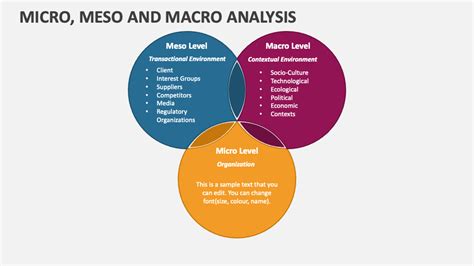Introduction
The scale of analysis refers to the level of magnification or granularity at which a researcher or practitioner examines a phenomenon. It encompasses the range of entities, processes, and interactions under investigation, from the broadest macro-level to the most specific micro-level. Understanding the appropriate scale of analysis is crucial for effective research and practical application.

Macro-Level Analysis
Definition
Macro-level analysis focuses on large-scale phenomena, such as societies, economies, and global systems. It considers aggregate patterns, trends, and relationships across broad geographic regions, industries, or time periods.
Examples
- Economic analysis: examining the performance of entire economies, including GDP growth, inflation, and unemployment
- Sociological analysis: studying social institutions, such as family, education, and religion, at the societal level
- Political analysis: analyzing political systems, ideologies, and international relations on a global scale
Benefits
- Broad perspective: Provides a comprehensive understanding of large-scale systems and their interactions
- Identifies trends: Detects patterns and trends that may not be visible at a smaller scale
- Informs policymaking: Supports the development of policies that address societal-level issues
Micro-Level Analysis
Definition
Micro-level analysis examines individual entities or units within a larger system. It focuses on specific behaviors, processes, and interactions at the smallest possible scale, such as individuals, families, or small groups.
Examples
- Psychological analysis: studying the thoughts, emotions, and behaviors of individuals
- Organizational analysis: examining the internal workings of organizations, including employee performance, communication, and decision-making
- Biological analysis: investigating the structure and functioning of cells, tissues, and organisms
Benefits
- Depth of understanding: Provides detailed insights into the specific mechanisms and interactions within a system
- Individualized interventions: Facilitates the development of targeted interventions and solutions for specific entities
- Validating customer perspectives: Encourages customer engagement by asking questions and understanding their experiences
Choosing the Appropriate Scale of Analysis
The choice of scale of analysis depends on the specific research question or practical problem being addressed. Here are some key considerations:
- Research objectives: The scale of analysis should match the level of detail required to answer the research questions.
- Data availability: The availability and granularity of data influence the choice of scale, as some data may only be available at certain levels of aggregation.
- Practical implications: The scale of analysis should be aligned with the intended practical applications, such as policy development or intervention design.
Step-by-Step Approach to Scale of Analysis
- Define the research question or problem: Clearly articulate the focus and objectives of the inquiry.
- Determine the appropriate level of magnification: Consider the size, complexity, and scope of the phenomenon being investigated.
- Collect data: Gather data from sources that provide the necessary granularity and representativeness.
- Analyze the data: Use appropriate statistical or qualitative methods to extract meaningful patterns and relationships.
- Interpret the findings: Draw conclusions based on the analysis, while considering the limitations of the scale of analysis.
Why Scale of Analysis Matters
Choosing the appropriate scale of analysis is crucial for several reasons:
- Avoids oversimplification: Prevents the researcher from overlooking important details at a lower level of analysis.
- Prevents generalization errors: Ensures that conclusions are not made too broadly or too narrowly based on the scale of the study.
- Focuses resources: Directs attention and resources to the most relevant aspects of the research problem.
Benefits of Scale of Analysis
Adopting a strategic approach to scale of analysis offers several benefits:
- Improved research quality: Leads to more rigorous and reliable findings.
- Enhanced decision-making: Facilitates informed decisions based on evidence from the appropriate scale.
- Increased customer engagement: Enhances customer satisfaction and loyalty by understanding their unique perspectives.
- Innovation and application: Identifies opportunities for new applications and solutions by considering different scales of analysis.
Innovative Word: “GranuLab”
To foster innovation, we propose the concept of “GranuLab,” a creative tool that helps generate ideas for new applications across different scales of analysis. GranuLab involves brainstorming and experimenting with various scales to explore potential synergies and novel insights.
Tables
| Scale | Examples | Benefits | Considerations |
|---|---|---|---|
| Macro | Economic analysis, societal trends | Broad perspective, identifies patterns | Data availability, aggregation issues |
| Micro | Psychological analysis, organizational dynamics | Depth of understanding, targeted interventions | Data collection challenges, operationalization |
| Mesolevel | Regional economic development, community dynamics | Intermediate level of detail, policy implications | Geographic boundaries, data integration |
| Nano-level | Molecular biology, subatomic interactions | Highly specialized, fundamental insights | Complexity, instrumentation limitations |
| Step | Action | Purpose | Outcome |
|---|---|---|---|
| 1 | Define research question | Determine the focus and objectives | Clear research direction |
| 2 | Determine scale of analysis | Consider size and complexity | Appropriate level of magnification |
| 3 | Collect data | Gather necessary data | Data availability and representativeness |
| 4 | Analyze data | Extract meaningful patterns | Insights and conclusions |
| 5 | Interpret findings | Draw conclusions | Evidence-based findings |
| Customer Perspective | Validation Questions | Benefits |
|---|---|---|
| Individual customer | How does the product/service meet your specific needs? | Enhanced satisfaction, personalized solutions |
| Group customer | What are the common challenges and opportunities faced by your group? | Tailored interventions, improved group cohesion |
| Community customer | How can the service benefit the wider community? | Increased social impact, community engagement |
| National customer | How does the issue affect the well-being of the nation? | Informed policymaking, collective action |
| Scale of Analysis | GranuLab Concepts | Potential Applications |
|---|---|---|
| Macro | Global economic trends | Forecasting economic growth, developing international partnerships |
| Micro | Employee motivation | Designing incentive systems, improving workplace culture |
| Mesolevel | Regional tourism patterns | Optimizing tourism infrastructure, promoting community development |
| Nano-level | Gene expression | Developing personalized medical treatments, advancing genetic research |
